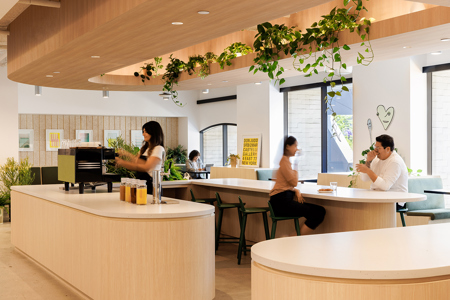

Tinder Headquarters
Rapt Studio
Client: Kelly Newton, Project Manager, SPMD (signage and environmental graphics)Pamela Saxton, VP Business Development, Western Office (furniture)Janie Robertson, Design Project Manager, Western Office (furniture)Mengyang Wu, PE, LEED AP, CPD Mechanical | Plumbing | Fire Protection Engineer, Alfatech (MEP Engineers) Diarmuid Hartley, Managing Partner, Alfatech (MEP Engineers)William Tri, Project Manager, Environmental Contracting Corporation (general contractor)Athena Abrol, Director Project and Development Services, Cresa (project manager)
With 55 billion matches made to date, Tinder is on a mission to keep the magic of human connection alive. The team at Tinder is motivated by the belief that a more connected world is a more interesting world, and they now have space to meet IRL themselves: the new Tinder headquarters in West Hollywood, where the company was founded 10 years ago. The 77,000-square-foot destination completed in March 2022 is designed to reinforce their drive to build genuine relationships — within their own teams, and by extension between the users they seek to support.
The experience begins upon entry to The Commons, modeled after a traditional town square. As the largest space, it facilitates casual bump-ins with colleagues and offers space to circulate and chat. On floor two, the café — or “Boost Bar” — pays homage to the local coffee shop. "LA Galleria" on floor five pulls elements from the workshops and displays of artist studios, while a decidedly quieter area can be found within The Stacks on floor six. This communal focus space acts like the reading room of your local library — albeit with a little more punch. The pinnacle space rests in a hidden corner of floor seven: dubbed “5 p.m.,” it draws on the private, exclusive qualities of a speakeasy, entering in through a false phone booth.
“The way people work is so unique to them,” says Nicole Senior, Tinder VP of Diversity, Equity and Inclusion. “Some people enjoy bright, vibrant, social spaces, while others need more quiet. Designing for these preferences matters, and makes people feel invited and included.”